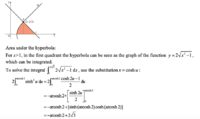You are using an out of date browser. It may not display this or other websites correctly.
You should upgrade or use an alternative browser.
You should upgrade or use an alternative browser.
Q on hyperbolic equation.
- Thread starter Sonal7
- Start date
Dr.Peterson
Elite Member
- Joined
- Nov 12, 2017
- Messages
- 16,605
So you know the "Pythagorean" identity for sinh and cosh?Thank you I forgot about that. I got it now. But how did they get 2 root 3. I know what cosh arcosh 2 is 2, but I cant see how you might know sinsh arcosh 2 is root 3. Any idea? Thank you v much.
Ok i got it. Its root 3 as if you rearranged cosh(arcosh 2) (ie =2) then sinh^2 (arcosh 2) is 1-4. Got it, thank you so much.So you know the "Pythagorean" identity for sinh and cosh?
[MATH]\frac{\sinh 2u}{2} = \frac{2\sinh u \cosh u}{2} = \sinh u \cosh u[/MATH]
remember this
if you have something and its inverse, they cancel each other
then
[MATH]\cosh \cosh^{-1} 2 = 2[/MATH] (they cancel each other)
And
[MATH]\sinh u = \sqrt{\cosh^2 u - 1}[/MATH]
[MATH]\sinh \cosh^{-1} 2 = \sqrt{(\cosh \cosh^{-1} 2)^2 - 1} = \sqrt{2^2 - 1} = \sqrt{4 - 1} = \sqrt{3}[/MATH]
then
[MATH]\sinh \cosh^{-1} 2 \cosh \cosh^{-1} 2 = \sqrt{3} \cdot 2 = 2\sqrt{3}[/MATH]
remember this
if you have something and its inverse, they cancel each other
then
[MATH]\cosh \cosh^{-1} 2 = 2[/MATH] (they cancel each other)
And
[MATH]\sinh u = \sqrt{\cosh^2 u - 1}[/MATH]
[MATH]\sinh \cosh^{-1} 2 = \sqrt{(\cosh \cosh^{-1} 2)^2 - 1} = \sqrt{2^2 - 1} = \sqrt{4 - 1} = \sqrt{3}[/MATH]
then
[MATH]\sinh \cosh^{-1} 2 \cosh \cosh^{-1} 2 = \sqrt{3} \cdot 2 = 2\sqrt{3}[/MATH]
I did that in my head, but it is good of you to do it for the rest of the public to learn from. I hadnt realised i made a typing error I meant to write sinh^2 (arcos 2) =4-1.[MATH]\frac{\sinh 2u}{2} = \frac{2\sinh u \cosh u}{2} = \sinh u \cosh u[/MATH]
remember this
if you have something and its inverse, they cancel each other
then
[MATH]\cosh \cosh^{-1} 2 = 2[/MATH] (they cancel each other)
And
[MATH]\sinh u = \sqrt{\cosh^2 u - 1}[/MATH]
[MATH]\sinh \cosh^{-1} 2 = \sqrt{(\cosh \cosh^{-1} 2)^2 - 1} = \sqrt{2^2 - 1} = \sqrt{4 - 1} = \sqrt{3}[/MATH]
then
[MATH]\sinh \cosh^{-1} 2 \cosh \cosh^{-1} 2 = \sqrt{3} \cdot 2 = 2\sqrt{3}[/MATH]
exact area is
[MATH]\int_{0}^{2\sqrt{3}} \left(10 - \frac{4y}{\sqrt{3}} - \sqrt{\frac{y^2}{4} + 1} \right) \ dy \ = \ 10\sqrt{3} - \sinh^{-1} \sqrt{3} \ = \ 10\sqrt{3} - \cosh^{-1} 2 [/MATH]
this is the beauty when you can find the whole area with only one integral
[MATH]\int_{0}^{2\sqrt{3}} \left(10 - \frac{4y}{\sqrt{3}} - \sqrt{\frac{y^2}{4} + 1} \right) \ dy \ = \ 10\sqrt{3} - \sinh^{-1} \sqrt{3} \ = \ 10\sqrt{3} - \cosh^{-1} 2 [/MATH]
this is the beauty when you can find the whole area with only one integral
Yes that was an obvious mistake. I noticed that. I did wish to ask why did you think they chose such as awkward u sub, why not cos u, why cosh u. I know its hyperbolic parametric values, is that why? would it matter ? bit of a dumb question, i m guessing its to do with value of the area we are trying to derive-its has an arcosh in it.also, one more thing
the limit of integration should be [MATH]\int_{1}^{2}[/MATH] with respect to [MATH] x[/MATH]
the book did it [MATH]\int_{1}^{2\sqrt{3}}[/MATH]
Yes that was an obvious mistake. I noticed that. I did wish to ask why did you think they chose such as awkward u sub, why not cos u, why cosh u. I know its hyperbolic parametric values, is that why? would it matter ? bit of a dumb question, i m guessing its to do with value of the area we are trying to derive-its has an arcosh in it.
you don't have to do it with hyperbolic [MATH]\cosh u[/MATH]
you can instead do it with trigonometric [MATH]\sec u[/MATH]
why [MATH]\cosh u[/MATH] or [MATH]\sec u[/MATH] ?
because you have to look for something similar to [MATH]\sqrt{x^2 - 1}[/MATH]
[MATH]\sinh u = \sqrt{\cosh^2 u - 1}[/MATH]
[MATH]\tan u = \sqrt{\sec^2 u - 1}[/MATH]
do you notice that they look like the square root?
but
[MATH]\sin u = \sqrt{1 - \cos^2 u}[/MATH]
i cannot use [MATH]\cos u[/MATH] because i want the integral to be [MATH] \sqrt{1 - x^2} [/MATH] to use it
you can also use [MATH]\csc u[/MATH]
because [MATH]\cot u = \sqrt{\csc^2 u - 1}[/MATH] which is similar to [MATH]\sqrt{x^2 - 1}[/MATH]
Last edited:
Thank you very muchyou don't have to do it with hyperbolic [MATH]\cosh u[/MATH]
you can instead do it with trigonometric [MATH]\sec u[/MATH]
why [MATH]\cosh u[/MATH] or [MATH]\sec u[/MATH] ?
because you have to look for something similar to [MATH]\sqrt{x^2 - 1}[/MATH]
[MATH]\sinh u = \sqrt{\cosh^2 u - 1}[/MATH]
[MATH]\tan u = \sqrt{\sec^2 u - 1}[/MATH]
do you notice that they look like the square root?
but
[MATH]\sin u = \sqrt{1 - \cos^2 u}[/MATH]
i cannot use [MATH]\cos u[/MATH] because i want the integral to be [MATH] \sqrt{1 - x^2} [/MATH] to use it


